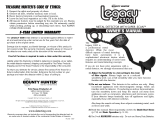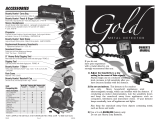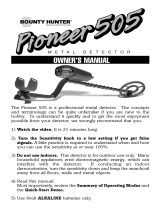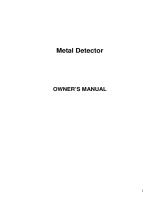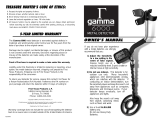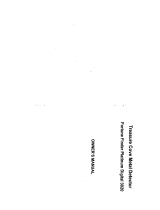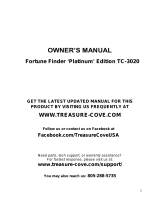Page is loading ...

METAL DETECTOR
OWNER’S MANUAL
If you do not have
prior experience with a
metal detector, we strongly
recommend that you:
1) Adjust the Sensitivity to a low
setting in the event of false signals.
Always begin use at a reduced sensitivity
level; increase to full sensitivity after you
have become familiar with the detector.
2) Do not use indoors. This detector is for outdoor use
only. Many household appliances emit electromagnetic energy,
which can interfere with the detector. If conducting an indoor
demonstration, turn the sensitivity down and keep the searchcoil
away from appliances such as computers, televisions and
microwave ovens. If your detector beeps erratically, turn off
appliances and lights.
Also keep the searchcoil away from objects containing metal, such
as floors and walls.
3) Use a 9-volt ALKALINE battery only.
Do not use Heavy Duty Batteries.

2
TABLE OF CONTENTS
Terminology . . . . . . . . . . . . . . . . . . . . . . . . . . . . . . . . . . . . . . .3
Assembly . . . . . . . . . . . . . . . . . . . . . . . . . . . . . . . . . . . . . . .4-5
Batteries . . . . . . . . . . . . . . . . . . . . . . . . . . . . . . . . . . . . . . . . .6
Quick-Start Demo . . . . . . . . . . . . . . . . . . . . . . . . . . . . . . . . . .7
Basics Of Metal Detecting . . . . . . . . . . . . . . . . . . . . . . . . . .8-9
Ground Minerals . . . . . . . . . . . . . . . . . . . . . . . . . . . . . . .8
Trash . . . . . . . . . . . . . . . . . . . . . . . . . . . . . . . . . . . . . . . .8
Identifying Buried Objects . . . . . . . . . . . . . . . . . . . . . . .8
Size and Depth of Buried Objects . . . . . . . . . . . . . . . . . .9
EMI . . . . . . . . . . . . . . . . . . . . . . . . . . . . . . . . . . . . . . . . .9
How To Work The Controls . . . . . . . . . . . . . . . . . . . . . . . . . .10
Operation and Controls . . . . . . . . . . . . . . . . . . . . . . . . . .10-12
MENU Selections
Disc . . . . . . . . . . . . . . . . . . . . . . . . . . . . . . . . . . . . . . . .11
Notch . . . . . . . . . . . . . . . . . . . . . . . . . . . . . . . . . . . . . .11
Sensitivity . . . . . . . . . . . . . . . . . . . . . . . . . . . . . . . . . . .12
Volume . . . . . . . . . . . . . . . . . . . . . . . . . . . . . . . . . . . . .12
Target Identification . . . . . . . . . . . . . . . . . . . . . . . . . . . . . . .13
Depth And Target Display . . . . . . . . . . . . . . . . . . . . . . . . . . .14
In The Field Techniques . . . . . . . . . . . . . . . . . . . . . . . . . .15-16
Headphones . . . . . . . . . . . . . . . . . . . . . . . . . . . . . . . . . . . . . .17
Trouble Shooting . . . . . . . . . . . . . . . . . . . . . . . . . . . . . . . . . .18
Code of Ethics . . . . . . . . . . . . . . . . . . . . . . . . . . . . . . . . . . . .19
Warranty . . . . . . . . . . . . . . . . . . . . . . . . . . . . . . . . . . . . . . . .19
Accessories . . . . . . . . . . . . . . . . . . . . . . . . . . . . . . .Back Cover

TERMINOLOGY
The following terms are used throughout the manual, and are standard
terminology among detectorists.
ELIMINATION
Reference to a metal being "eliminated" means that the detector will
not emit a tone, nor light up an indicator, when a specified object
passes through the coil’s detection field.
DISCRIMINATION
When the detector emits different tones for different types of metals,
and when the detector "eliminates" certain metals, we refer to this
as the detector "discriminating" among different types of metals.
Discrimination is an important feature of professional metal
detectors. Discrimination allows the user to ignore trash and
otherwise undesirable objects.
RELIC
A relic is an object of interest by reason of its age or its association
with the past. Many relics are made of iron, but can also be made
of bronze or precious metals.
IRON
Iron is a common, low-grade metal that is an undesirable target in
certain metal detecting applications. Examples of undesirable iron
objects are old cans, pipes, bolts, and nails.
Sometimes, the desired target is made of iron. Property markers,
for instance, contain iron. Valuable relics can also be composed of
iron; cannon balls, old armaments, and parts of old structures and
vehicles can also be composed of iron.
FERROUS
Metals which are made of, or contain, iron.
PINPOINTING
Pinpointing is the process of finding the exact location of a buried
object. Long-buried metals can appear exactly like the surrounding
soil, and can therefore be very hard to isolate from the soil.
PULL-TABS
Discarded pull-tabs from beverage containers are the most bothersome
trash items for treasure hunters. They come in many different shapes
and sizes. Pull-tabs can be eliminated from detection, but some other
valuable objects can have a magnetic signature similar to pull-tabs, and
will also be eliminated when discriminating out pull-tabs.
GROUND BALANCE
Ground Balancing is the ability of the detector to ignore, or "see
through," the earth’s naturally occurring minerals, and only sound
a tone when a metal object is detected. This Detector incorporates
proprietary circuitry to eliminate false signals from severe ground
conditions
3

4
ASSEMBLY
●
1 Position S-Rod upright.
●
2 Rotate the LOCKING COLLAR fully in
the counterclockwise direction.
●
3 Insert your finger inside the tube and make
sure the INTERNAL CAM LOCK is flush with the inside
of the tube.
●
4
Insert the MIDDLE STEM into the S-ROD, with the
SILVER BUTTON pointed upward
●
5 Rotate the MIDDLE STEM until the
SILVER BUTTON locates in the hole.
●
6 Twist the LOCKING COLLAR fully in
the clockwise direction until it locks.
●
7 Repeat this process on the LOWER STEM.
●
8 Using the BOLT and KNURLED KNOB, attach
the SEARCHCOIL to the LOWER STEM.
●
9
Adjust the LOWER STEM to a length that lets you
maintain a comfortable upright posture, with your arm
relaxed at your side, and the SEARCHCOIL parallel to
the ground in front of you.
●
10
Wind the CABLE securely around the STEMS.
●
11
Connect CABLE PLUG to housing.
Do not twist the Cable or Plug. Turn Locking Ring
only. Use minimal finger pressure to start the
threads. Do not cross-thread. When the Locking
Ring is fully engaged over the threaded
connector, give it a firm turn to make sure that it is
very tight. When the Locking Ring is fully engaged over
the threaded connector, it may not cover all of the threads.
●
12
Tighten both LOCKING COLLARS.
S-ROD
LOCKING
COLLAR
INTERNAL
CAM LOCK
SILVER BUTTON
MIDDLE
STEM
S-ROD
MIDDLE STEM
●
2
●
3
●
4
●
4
●
5
*
Note: Very tall users can purchase the optional Extended Lower Stem (TUBE5X), for extended reach.
Caution:
Forcing in MIDDLE STEM with CAM LOCK raised may form a burr on
camlock. If this happens, remove burr with knife to allow insertion.
Locking
Collar
S-Rod
Velcro
Strap
Velcro
Strap
Knurled
Knob
Bolt
Serchcoil
Hand-grip
Searchcoil
Cable
Cable
Plug
Locking
Collar
Upper
Stem

5
ASSEMBLY
(
continued)
Arm Rest Strap (not included)
Some users prefer to use a
strap when swinging the
detector vigorously, in order to
hold the detector secure
against the arm. The strap may
be purchased as an optional
accessory.
The detector can also be used
without the strap with no
compromise to detector
balance and stability under
most conditions.
Battery
Compartment
(back side)
Searchcoil
Knurled
Knob
Hand-grip
Nut
Screw
Searchcoil
Cable
Cable
Plug
S-Rod
armrest
Velcro
Strap
Locking
Collar
Locking
Collar
Upper
Stem
1/4” Headphone Jack
Optional Arm Strap

6
The detector requires a single 9-volt ALKALINE battery (battery not included).
Do not use ordinary zinc carbon batteries.
Rechargeable batteries can also be used.
If you wish to use rechargeable batteries, we recommend using a
Nickel Metal Hydride rechargeable battery.
The battery compartment is located on the back side of the housing.
Slide the battery door to the side and remove it to expose the battery
compartment.
BATTERY LIFE
Expect 20 to 25 hours of life from a 9-volt alkaline battery.
Rechargeable batteries provide about 8 hours of usage per charge.
SPEAKER VOLUME AND BATTERY CHARGE
You may notice the speaker volume drop while one battery segment is
illuminated.
With one segment flashing, low speaker volume will be very apparent.
BATTERY INDICATOR
The 3-segment battery indicator has 4 stages of indication.
These indications are accurate for a 9-volt alkaline battery.
Segments Illuminated
Battery Voltage
3 -segments more than 8.3 volts
2 -segments more than 7.0 volts
1 -segment more than 6.2 volts
1 -segment flashing less than 6.2 volts
After the battery indicator begins flashing, expect the detector to shut off
within 10 minutes.
A rechargeable battery will usually illuminate all segments throughout
most of its useful charge. But as soon as it drains to the 2-segment level,
it will then discharge very rapidly.
BATTERIES

7
QUICK-START DEMONSTRATION
I. Supplies Needed
• a Nail • a Zinc Penny (dated after 1982)
• a Nickel • a Quarter
II. Position the Detector
a. Place the detector on a table, with the
searchcoil hanging over the edge.
Or better, have a friend hold the detector,
with the searchcoil off the ground.
b. Keep the searchcoil away from walls,
floors, and metal objects.
c. Remove watches, rings, and jewelry.
d. Turn off lights or appliances, whose
electromagnetic emissions may cause interference.
e. Pivot the searchcoil back.
III. Power Up. Press .
IV. Wave each object over the searchcoil.
a. Notice a different tone for each object:
Low Tone: Medium Tone: High Tone:
Nail Zinc Penny, Nickel Quarter
b. Motion is required.
Objects must be in motion over the searchcoil to be detected.
V. Then press .
a. The word “IRON” disappears from the display
VI. Wave the nail over the searchcoil.
a. The nail will not be detected
b. The nail has been “discriminated out.”
VII. Press four more times.
a. The words FOIL, 5¢, ALUM, and ZINC disappear.
VIII. Wave the nickel
a. The nickel will not be detected.
IX. Press to toggle down to NOTCH.
Then press 3 times
a. 5¢ reappears on the display
X. Wave the Nickel.
a. The nickel is now again detected.
b. The nickel has been “notched in.”

8
THE BASICS OF METAL DETECTING
A hobby metal detector is intended for locating buried metal objects.
When searching for metals, underground or on the surface, you have the
following challenges and objectives:
1. Ignoring signals caused by ground minerals.
2. Ignoring signals caused by metal objects that you do not want to
find, like pull-tabs.
3. Identifying a buried metal object before you dig it up.
4. Estimating the size and depth of objects, to facilitate digging them up.
5. Eliminating the effects of electromagnetic interference from other
electronic devices.
Your GOLD metal detector is designed with these things in mind.
1. Ground Minerals
All soils contain minerals. Signals from ground minerals can interfere
with the signals from metal objects you want to find. All soils differ, and
can differ greatly, in the type and amount of ground minerals present.
The detector incorporates an automated ground-balancing feature
which will eliminate false signals from most types of soils.
There is no user adjustment. If you experience false signals from
severe ground conditions, such as highly mineralized soil found in
many gold prospecting locations, or red-clay soils, reduce sensitivity.
2. Trash
If searching for coins, which will induce higher tone sounds, you want
to ignore items like aluminum foil, nails, and pull-tabs. These
undesirable items induce lower tones. You can listen to the sounds of
all objects detected, and decide on what you want to dig up. Or you
can eliminate unwanted metals from detection by using the
DISCRIMINATION feature.
3. Identifying Buried Objects
Different objects induce different tones (high, medium, low) and are
classified on the display screen in different categories from left to right.

9
4. Size and Depth of Buried Objects
The relative depth of an object is displayed at the left of the display as
a 1 digit number, 0 to 9 inches. The size of an object can be
determined using sweep techniques described later in the manual.
5. Electromagnetic Interference (EMI)
The searchcoil produces a magnetic field and then detects changes in
that magnetic field caused by the presence of metal objects. This
magnetic field that the detector creates is also susceptible to the
electromagnetic energy produced by other electronic devices. Power
lines, microwave ovens, lighting fixtures, TVs, computers, motors,
etc…. all produce EMI which can interfere with the detector and cause
it to beep when no metal is present, and sometimes to beep erratically.
The SENSITIVITY control lets you reduce the strength of this magnetic
field, and therefore lessen its susceptibility to EMI. You may want to
operate at maximum strength, but the presence of EMI may make this
impossible, so if you experience erratic behavior or “false” signals,
reduce the sensitivity.
THE BASICS
(
continued)

10
OPERATION and CONTROLS
While in DISCRIMINATION
mode, press and hold
the Pinpoint button to
actuate PINPOINT.
While in ALL-METALS
mode, press and hold
the Pinpoint button to
actuate GROUND GRAB.
Press MENU button
to select the
menu item you
want to adjust.
Press MODE button
to TOGGLE between
the Discrimination and
All-Metals modes.
POWER
ON/OFF
Press or Buttons
to CHANGE THE SETTING
of the active menu item.
The active menu item is
the Highlighted line on the
left side of the display.
Press or Buttons
to CHANGE THE SETTING
of the active menu item.
The active menu item is
the Highlighted line on the
left side of the display.
HOW TO WORK THE CONTROLS
POWERING UP
Press
• The detector always starts up with the DISCRIMINATION feature
active.
• Motion is required to detect metal.
• Sensitivity is at 70% of maximum
• All target categories are illuminated, meaning that all metal objects
will be detected.

11
OPERATION and CONTROLS
(
cont.)
MENU SELECTIONS
1. DISC
Use and to increase or decrease DISCRIMINATION level.
Each time you press , a target category is eliminated from detection.
Elimination occurs from left to right. When a category description (for
example “IRON”) disappears from the display, then targets classified in
that category will not be detected.
Pressing reverses the discrimination process. With each press of
, a category description will reappear, indicating that targets
classified in that category will again be detected.
Discrimination is a cumulative elimination system. Targets can be
eliminated from left to right on the scale, with each additional press of
, resulting in more objects being eliminated from detection.
2. NOTCH
Press until “NOTCH” is illuminated on the display.
Use and to notch target categories IN or OUT while the NOTCH
line is highlighted.
Whereas the discrimination feature eliminates all categories sequentially
from detection, the NOTCH control allows you to selectively include or
exclude target categories from detection.
With each press of or , the notched category moves across the
display screen. As you move the position of the notched category, you
are
changing the detection status of the selected category.
• If a target category was previously eliminated (word not visible)
then notching that category will return it to detection.
• If a target category was previously retained (word is visible) then
notching that category will remove it from detection.
Only one target category at a time can be selected for notching. To notch
multiple categories in or out, press again while NOTCH is
highlighted. Each subsequent press of allows you to set an additional
notch. Each time you press , followed by , the notch
program will begin by changing the status of the IRON segment.
At any time, the display screen indicates the current category notches or
discrimination settings. Any category whose description is not visible will
not be detected.

OPERATION and CONTROLS
(
cont.)
NOTCH
continued
For example, the following settings
tell us that:
• The nickel, dime, quarter, and
50¢+ categories will be
detected.
• All other categories of targets
(iron, foil, alum, and zinc) will
not be detected.
3. SENSITIVITY
Use and to increase or
decrease sensitivity while the SENS line is highlighted.
Maximum sensitivity is indicated by 5 bars.
Minimum sensitivity is indicated by 1 bar.
If the detector beeps erratically or beeps when there are no metal objects
being detected, reduce the sensitivity.
The searchcoil produces a magnetic field and then detects changes in that
magnetic field caused by the presence of metal objects. This magnetic field that
the detector creates is also susceptible to the electromagnetic energy produced by
other electronic devices. Power lines, microwave ovens, lighting fixtures, TVs,
computers, motors, etc…. all produce EMI which can interfere with the detector
and cause it to beep when no metal is present, and sometimes to beep erratically.
HOW DEEP WILL IT GO?
The Gold Metal Detector will detect a coin-sized object, like a quarter, to a
distance of about 9” from the searchcoil. Large metal objects can be
detected to a depth of several feet. Detectability is directly related to the size
of the metal object -- the larger the object, the deeper it can be detected.
Accuracy of target identification is also related to distance from the coil. Beyond
a distance of 8”, the accuracy of target identification begins to diminish.
4. VOLUME
While the VOLUME line is highlighted, use and to change the
speaker volume.
The default volume setting is 9. Maximum is 9.
Minimum is 0 (volume off). At levels 1, 2 and 3, high tones will be
inaudible or barely audible.
The speaker volume will diminish as battery voltage drops. For
maximum speaker volume, use 1 or 2 tones, as the low and bass tones
generate the loudest sounds.
menu
12

13
TARGET IDENTIFICATION
Targets are identified both audibly and visually as follows:
1. Different pitch tones for different types of metals
2. An illuminated icon within the target category best describing it.
AUDIO TARGET IDENTIFICATION:
Tones identify targets as follows:
LOW TONE
Ferrous objects, such as iron and steel, like nails and tin cans.
Smallest-sized gold objects and steel bottle caps
MEDIUM TONE
Newer pennies (post-1982 are minted from zinc)
Larger gold pieces, small brass objects, and most bottle screw
caps.
Foil, pull-tabs, nickels and most recent-vintage non-US coins.
HIGH TONE
Silver and copper coins, large brass objects
Older pennies (pre-1982 were minted from copper)
Dimes, quarters, half-dollars, silver dollars
Susan B. Anthony and Sacagawea dollar coins
Flattened aluminum cans (with a stronger signal than a coin)
Audio Target Identification (ATI) classifies metals into three categories.
LOW TONE
Nails & Steel Bottle Caps,
& Small Gold
MEDIUM TONE
Pull-Tabs, Nickels, Smaller &
Larger Gold, Zinc Pennies
(Post-1982), Many screw caps
HIGH TONE
Copper, Silver & Brass
Copper Pennies (Pre-1982)

14
READING THE DISPLAY
The Liquid Crystal Display (LCD) shows the
PROBABLE identification of the targeted
metal, as well as the PROBABLE depth of
the target.
The detector will register a consistent target
identification, upon each sweep of the coil,
when a buried target has been located and
identified. If, upon repeated passes over
the same spot, the target identification
reads inconsistently, the target is probably
a trash item, or oxidized metal. With
practice, you will learn to unearth only the
repeatable signals.
The segment identifications are highly
accurate, when detecting the objects
described on the label. However, if an
object registers in a given category for an
unknown buried object, you could be
detecting a metallic object other than the
object described on the label, but with the
same metallic signature. Also, the greater
the distance between the target and the
coil, the less accurate the target
identification.
GOLD TARGETS
Gold objects will
register on the left side of the LCD scale.
Gold flakes
will register under iron.
Small gold items
will register under
foil or 5¢.
Medium-sized gold items
will
register between 5¢ and Alum.
Large gold items
will register under
Zinc.
SILVER TARGETS:
Silver objects will
register to the right of the scale, under
Dime, Qts. or 50¢+.
IRON:
All but the very largest iron objects
will register on the far-left side of the scale.
This could indicate a worthless item such as
a nail, or a more valuable historic iron relic.
FOIL:
Aluminum foil, such as a gum
wrapper, will register as foil. A small
broken piece of pull tab may also register
here.
NICKEL:
Most newer pull-tabs from
beverage cans, the type intended to stay
attached to the can, will register here. Many
gold rings will also register here.
PT:
Older pull tabs, which always
detached completely from the can, register
here. Many medium size gold ring also
register here.
ZINC:
Newer US pennies (post-1982),
and Canadian $1 and $2 coins register
here. Many non-US coins of recent vintage
will also register here.
DIME:
Dimes and older copper pennies
(pre-1982) register here.
50¢+ Qts:
Quarters register here, Silver
Dollars, Half-Dollars and very large iron
objects, like a sewer lid, will register here.
Caution:
The target indications are visual
references. Many other types of metal can
fall under any one of these categories.
While the detector will eliminate or indicate
the presence of most common trash items,
it is impossible to accurately classify ALL
buried objects.
DEPTH INDICATOR: The Depth Indicator is
accurate for coin-sized objects. It indicates
the depth of the target, in inches.
Large and irregularly-shaped objects will
yield less reliable depth readings
When passing over an object, the
indicators will light up and stay illuminated
for three seconds. If the depth indication
varies with each sweep, try sweeping at
different angles; there may be more than
one target present. With practice, you will
learn the difference between accurate
readings, multiple targets, and highly
erratic readings which evidence trash or
irregularly shaped objects.
DEPTH AND TARGET DISPLAY

IN THE FIELD TECHNIQUES
15
When pin point ing a tar get, try draw ing an “X”,
as il lus trat ed, over where the tone is induced.
PINPOINTING
Accurate pinpointing takes practice
and is best ac com plished by “X-
ing” the target area.
1. Once a buried target is in di cat ed
by a good tone response,
continue sweep ing the coil over
the target in a nar row ing
side-to-side pat tern.
2. Take visual note of the place on
the ground where the “beep”
sounds.
3. Stop the coil directly over this
spot on the ground.
4. Now move the coil straight
for ward and straight back
towards you a cou ple of times.
5. Again make visual note of the
spot on the ground at which
the “beep” sounds.
6. If needed, “X” the target at
different an gles to “zero in” on
the ex act spot on the ground at
which the “beep” sounds.
COIL MOVEMENT
When swing ing the coil, be care -
ful to keep it level with the
ground about one inch from the
sur face. Nev er swing the coil like
a pen du lum.
CORRECT
WRONG

IN THE FIELD TECHNIQUES
(
continued)
Swing the searchcoil slowly,
overlapping each sweep as you move
forward. It is important to sweep the
coil at a consistent speed over the
ground as you search. After
identifying a target, your sweep
technique can help in identifying both
the location and the nature of the
target. If you encounter a weak
signal, try moving the coil in short,
rapid sweeps over the target zone;
such a short rapid sweep may
provide a more consistent target
identification.
Most worthwhile objects will
respond with a repeatable tone. If the
signal does not repeat after sweeping
the coil directly over the suspected
target a few times, it is more than
likely trash metal.
Crossing the target zone with
multiple intersecting sweeps at
multiple angles is another way to
verify the repeatability of the signal,
and the potential of the buried target.
To use this method, walk around the
target area in a circle, sweeping the
coil across the target repeatedly, every
30 to 40 degrees of the circle, about
ten different angles as you walk
completely around the target. If a
high-tone target completely
disappears from detection at a given
angle, chances are that you are
detecting oxidized ferrous metals,
rather than a silver or copper object.
If the tone changes at different angles,
you may have encountered multiple
objects. If you are new to the hobby,
you may want to dig all targets at first.
With practice in the field, you will
learn to better discern the nature of
buried objects by the nature of the
detector’s response.
You may encounter some false
signals as you proceed. False signals
occur when the detector beeps, but
no metal target is present. False
signals can be induced by
electromagnetic interference,
oxidation, or highly mineralized
ground soils. If the detector beeps
once, but does not repeat the signal
with several additional sweeps over
the same spot, there is probably no
target present.
When searching very trashy ground,
it is best to scan small areas with
slow, short sweeps. You will be
surprised just how much trash metal
and foil you will find in some areas.
The trashiest areas have been
frequented by the most people, and
frequently hold the most promise for
finding the most lost valuables.
Also maintain the searchcoil
positioned just above the surface of
the ground, without making contact
with the ground. Making contact with
the ground can cause false signals.
WHAT
READS
LIKE THIS
…MAY AC-
TUALLY BE
THIS
16

17
HEADPHONE JACK
Headphone
Jack
The detector has a 1/4” headphone jack on the left side of the housing.
When the headphone jack is connected, speaker audio is disabled.
USING HEADPHONES
(
not included)
Using a detector with headphones facilitates detection of the weak-
est signals and also extends the battery life.
It also allows you to hear subtle changes in the sound more clearly, particularly
if searching in a noisy location. For safety reasons, do not use headphones
near traffic or where other dangers are present. This device is to be used with
interconnecting cables/headphone cables shorter than three meters.

18
TROUBLESHOOTING GUIDE
SYMPTOM CAUSE SOLUTION
Detector chatters • Using detector • Use detector
or beeps erratically indoors outdoors only
• Using detector near • Move away
power lines
from power lines
• Using 2 detectors in • Keep 2 detectors
close proximity at least 20’ apart
• Environmental •
Reduce sensitivity
electromagnetic until erratic
interference signals cease
Constant low tone •
Discharged battery
• Replace battery
or
constant repeating
tones
• Wrong type of • Use only 9V
battery alkaline battery
LCD does not lock • Multiple targets •
Move coil slowly
on to one Target-ID present at different angles
or detector emits • Highly oxidized • Only dig up
multiple tones target repeatable signals
• Sensitivity set • Reduce sensitivity
too high
No power, no • Dead battery • Replace battery
sounds
• Cord not connected •
Check connections
securely
TROUBLESHOOTING

19
TREASURE HUNTER‘S CODE OF ETHICS:
• Always check Federal, State, County and local laws before searching.
• Respect private property and do not enter private property without the owner‘s per-
mission.
• Take care to refill all holes and leave no damage.
• Remove and dispose of any and all trash and litter found.
• Appreciate and protect our inheritance of natural resources, wildlife and private
property.
• Act as an ambassador for the hobby, use thoughtfulness, consideration and couresy
at all times.
• Never destroy historical or archaeological treasures.
• All treasure hunters may be judged by the example you set; always conduct yourself
with courtesy and consideration of others.
DISPOSAL
Dispose of the packaging materials properly, according to their type, such as
paper or cardboard.Contact your local waste-disposal service or environmental
authority for information on the proper disposal.
Do not dispose of electronic devices in the household garbage! As per Directive
2002/96/EC of the European Parliament on waste electrical and electronic equipment
and its adaptation into Ger-man law, used electronic devices must be collected sepa-
rately and recycled in an environmentally friendly manner.
In accordance with the regulations concerning batteries and rechargeable batteries, dis-
posing of them in the normal household waste is explicitly forbidden. Please make sure
to dispose of your used batteries as required by law — at a local collection point or in the
retail market. Disposal in domestic waste violates the Battery Directive.
EC DECLARATION OF CONFORMITY
Bresser GmbH has issued a „Declaration of Conformity“ in accordance with applicable
guidelines and corresponding standards. This can be viewed any time upon request.
WARRANTY & SERVICE
The regular guarantee period is 2 years and begins on the day of purchase. Tom an ex-
tended voluntary guarantee period as stated on the gift box, registration on our website is
required. You can consult the full guarantee terms as well as information on extending the
guarantee period and details of our services at www.bresser.de/warranty_terms
These operating instructions are to be considered a component of the device. Please read
the safety instructions and the operating instructions carefully before use. Keep these in-
structions for renewed use at a later date. When the device is sold or given to someone else,
the instruction manual must be provided to the new owner/user of the product.
Bresser GmbH
Gutenbergstr. 2
DE-46414 Rhede
www.bresser.de • info@bresser.de
Errors reserved -
technical specifications subject to change.
Copyright© 2018 by First Texas Products, L.L.C.
All rights reserved. Bounty Hunter® is a registered trademark of
First Texas Products, L.L.C. Made in China.

ACCESSORIES
Gold
Prospecting Kits
FOR COMPLETE DETAILS VISIT WWW.DETECTING.COM • 1-800-413-4131
Bounty Hunter
®
Carry Bag
Rugged double-stitched construction. CBAG-W
Bounty Hunter
®
Pouch & Digger Combo
Pouch with 2 large pockets & 9” heavy duty digging tool. TP-KIT-W
Stereo Headphones
Use with Bounty Hunter metal detectors. Lightweight and adjustable with
true stereo sound, adjustable volume, 1/8“ jack with 1/4” adaptor,
4’ cable.
HEAD-W
Pinpointer
Pinpoints the exact location of buried metal objects. Audio signal indicator
and vibrator. Runs on (1) 9-Volt Battery. PINPOINTER-W
Bounty Hunter
®
Sand Scoop
Large scoop with filtering holes. Made of strong plastic. SAND SCOOPBH
Replacement/Accessory Searchcoils
8” Replacement Standard Coil- 8COIL-7B13
10” Concentric Accessory Coil- 10COIL-BH
11” Biaxial Accessory Coil-- 11COIL-BH
Searchcoil Covers
Protect your coil from abrasion and damage.
8” Coil Cover - 8COVER-7
10” Coil Cover - F70COVER
11” Coil Cover - COVER-11DD
9” Heavy-Duty Digging Tool
Metal blade with comfortable plastic handle and depth gauge TROWEL-2
Digging Tool
Light and practical wide blade digging tool. TROWEL-W
Bounty Hunter
®
T-Shirt
100% cotton with Bounty Hunter
®
Logo. Sizes – S, M, LG, XL & XXL
- BHTSHIRT
Rain Cover
Neoprene- RAINCOV-DELTA
Bounty Hunter
®
Baseball Cap
One size fits all, with Bounty Hunter
®
logo. - BHCAP
MGLDG Rev.0 072018
/




